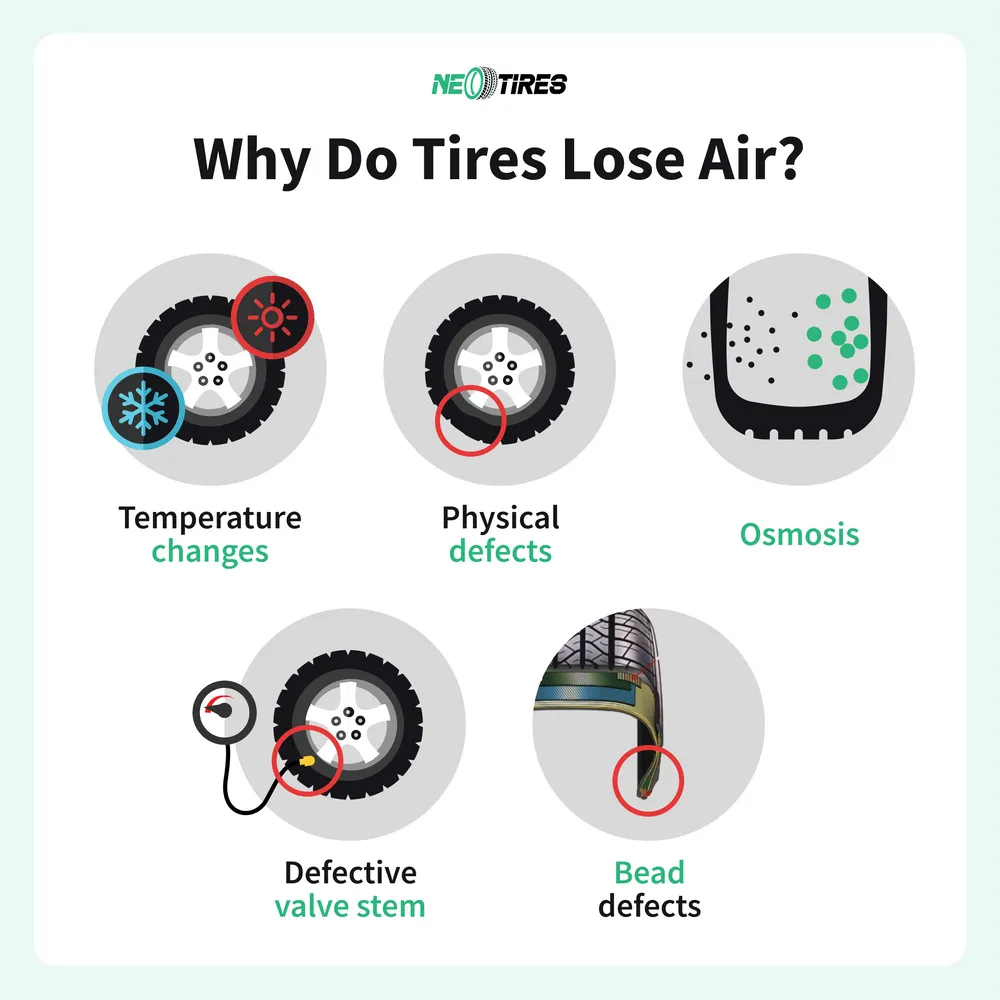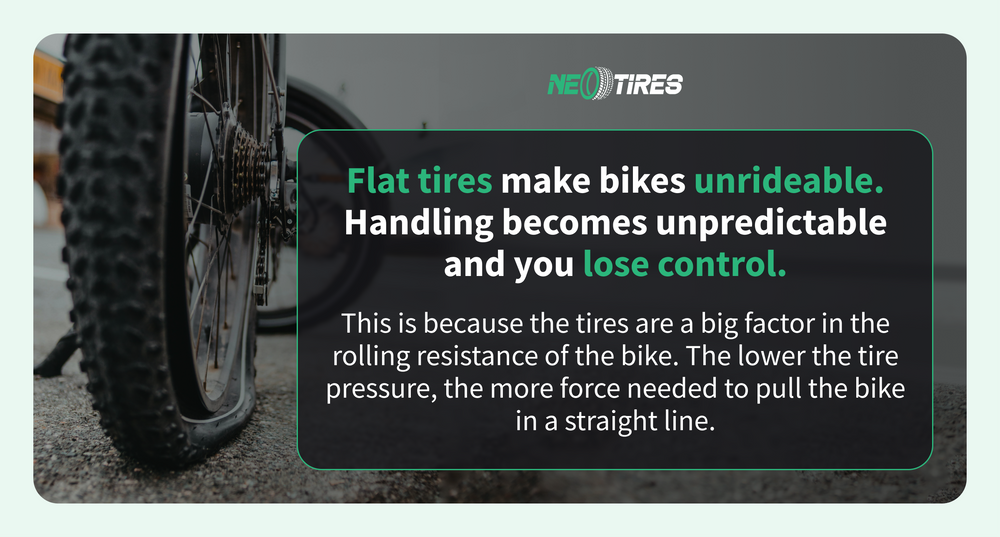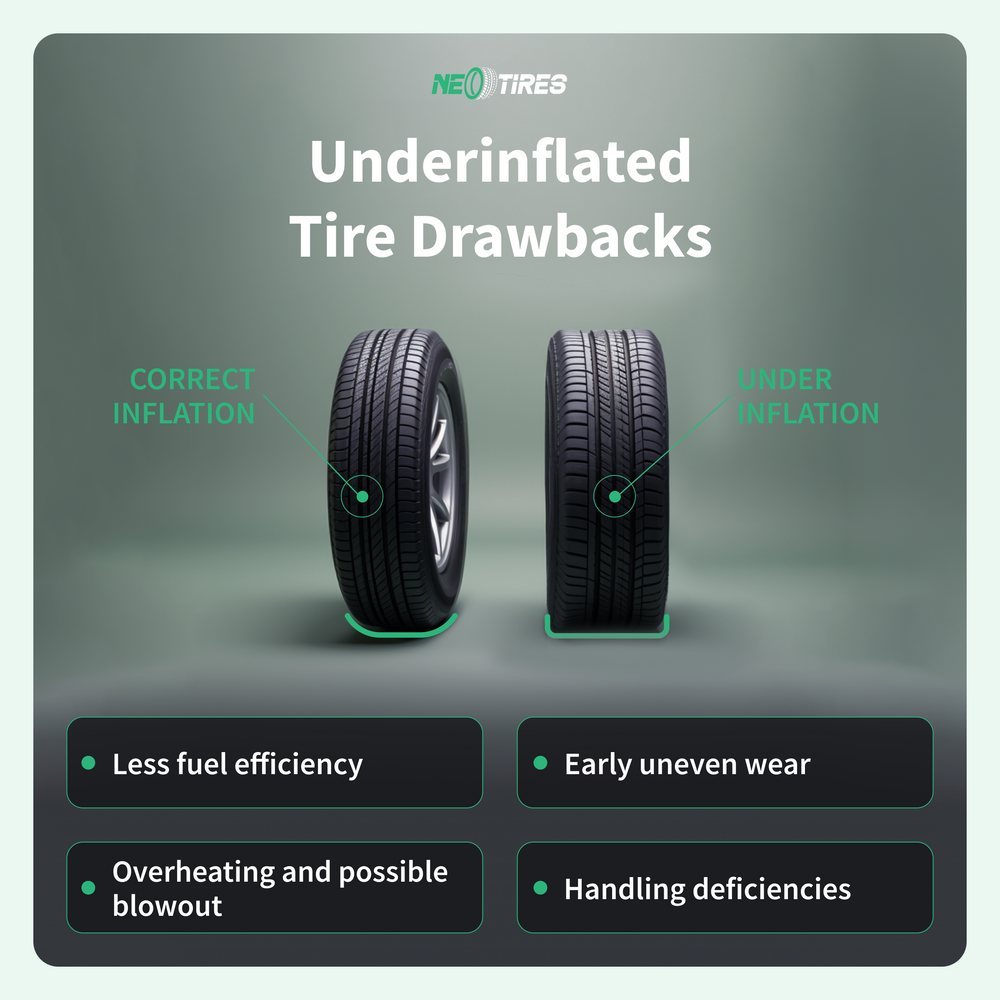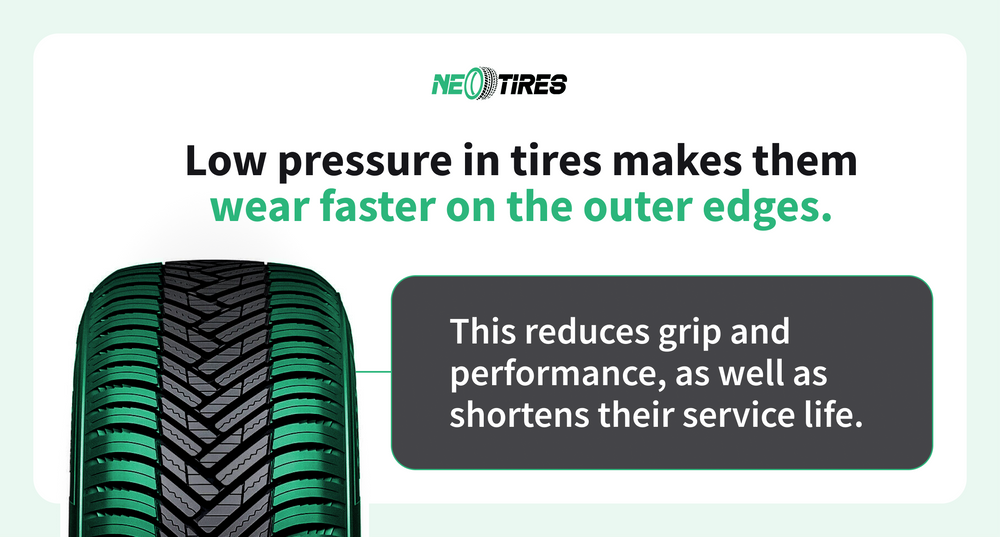You probably know how important tire size, tread, and pattern are for your driving safety and balance on the road. But did you know that the pressure in them plays an equally important role? In fact, the level of compressed air in the tires determines the way the vehicle consumes fuel, its performance in various conditions, and tire longevity.
I recently talked in detail about the reasons why tire overinflation is a bad idea. Today we will talk exclusively about underinflation, which is a common phenomenon, but no less risky than too much air in the tires. The good thing is that modern vehicles have TPMS that alerts the driver about a potential loss of air from the tires. Consequently, drivers can take measures immediately, preventing low pressure from severely affecting the tire condition.
However, there are situations when the TPMS is not functional for some reason or drivers simply ignore the underinflation in the wrong belief that it is not as serious as it seems. In this post, NeoTires mechanics explained all the risks and consequences of tire underinflation. We invite you to take a look.
Why Do Tires Lose Air?
Even if you take care of the pressure in your tires, they tend to lose air anyway, more or less. Many drivers opt for nitrogen instead of compressed air in their tires. The nitrogen stays more constant in tires and the loss of pressure is somehow less likely. Either way, if we talk about the reasons why a tire could lose pressure, they include but are not limited to:
-osmosis: this is a natural process through which oxygen molecules pass through the tire shell. This is a rather slow process but it can still lead to low tire pressure if levels are not regularly adjusted;
-weather changes: underinflation can occur when temperatures cool down. This is explained by air molecules compressing when the weather cools. This leads to tire pressure drop;
-certain tire damages that could lead to air leakage. For example, the valve stem cap could be defective which leads to gradual but constant air loss. Often, it could be about tire sidewall damage which could also be a premise for pressure deficiency.
Either way, it is absolutely normal for a tire to lose 1-2 PSI per month without any serious reason under normal driving conditions. So, even if you pump enough air once in a while, this does not guarantee that the pressure will remain constant for a long time. It tends to decrease even without serious reasons, which is a crucial premise to check and adjust the pressure level regularly.
What Are the Consequences of Tire Underinflation?
Many drivers ask us which of the 2 is more hazardous: tire over or underinflation? We always claim that both bring about a chain of adverse effects and put the drivers' safety at risk. We encourage drivers to avoid both too much and too little air in the tires to ensure optimal tire performance and avoid any risks. Let's see what risks are involved when drivers avoid adjusting the tire pressure in time.
Underinflation Impacts Fuel Economy
Show me a driver who doesn't want to save some gas. All motorists embrace this goal and seek for their tires to be as fuel-efficient as possible. The reason is obvious: nobody likes to spend too much on frequent gas pumping. If you also align to optimize fuel consumption, then you must know that low tire pressure is not at all the right way to achieve it. What is the connection between tire low pressure and fuel consumption? Let me explain this.
Each vehicle, or rather its engine, exerts a certain effort to propel the tires forward. The tires oppose a certain resistance in this process, depending on the size, the rubber formula, design, etc... This process is known as tire rolling resistance. The lower this resistance is, the easier the tire rolls on the road without much effort from the engine.
Contrastingly, the higher the rolling resistance, the more the engine is called for to propel the wheel forward, which entails a generous fuel consumption. A deflated tire generates more rolling resistance. This is because of its loose shape at the edges which puts more rubber on the road surface. More rubber means more effort in propelling it forward. Consequently, the fuel burning increases significantly because the vehicle spends more energy pushing the rubber forward.
To illustrate the point, think of a bicycle with fully deflated tires:
How easy is it to press its pedals? How handy is the bike? Can you sense the excessive effort you have to exert to move it forward and maintain its balance? It is very difficult and sometimes even impossible because of the highly unstable maneuverability.
I might exaggerate the example, but I want you to understand that a similar phenomenon takes place in the scenario of a vehicle. The engine has to exert a lot of effort to push the wheels on underinflated tires. This increases fuel consumption, which is just one of the adverse effects of tire low pressure.
Underinflation Leads to Handling Issues
A tire with too low pressure provides more flex in sidewalls than it should. The outer edges have an abnormal shape. Such a shape will deliver an unstable cornering because the tire is not able to provide the necessary stability due to too much flex.
A very hot topic regarding tire low pressure is its braking distance. Many sources suggest that underinflation is a prerequisite for a longer stopping distance. Taking into account that the shape of the tire is slightly relaxed at the edges, this, hypothetically, would increase the stopping distance.
However, some studies suggest that a slightly underinflated tire can brake better. This would be explained by the larger contact patch that would provide better grip and would allow the under-inflated tire to transfer greater brake forces and provide a shorter stopping distance.
In fact, many other elements also influence the braking distance in addition to the pressure in them. Here we refer to friction, ground surface, rubber formula, and many others that also play an essential role in tire braking capacity. In any case, both the sources that support slight underinflation for short braking and those that are against it have a common point: they both agree that underinflation is disadvantageous for the handling and stability points of view.
Having said that, less than recommended pressure in tires will necessarily lead to lazier steering, more sloppy responsiveness, and unbalanced cornering. This set of effects increases the risk of poor vehicle handling. The right way to go is to stick to the manufacturer's pressure recommendations that ensure optimal performance as well as safe braking.
Underinflation Can Lead To Tire Blowout
One of the most traumatic driving experiences is a tire blowout. It destroys completely the tire integrity. Worse than that, a blowout puts the health and safety of the driver and his passengers at risk. One of the most common causes of tire blowouts is underinflation. This is how things happen under such conditions:
A tire with low pressure has highly flexible sidewalls and forms a larger contact patch with the ground. This serves as a premise for heat build-up in them due to the higher level of friction. The more heat accumulates in them, the more sensitive the tire becomes to a potential blowout. This means that the heat inside reaches such a high level that it affects the integrity of the tire. As a result, it suddenly separates through a blowout that puts the driver's safety at risk.
The risk of a blowout is mainly more imminent at high speed. That's when the tire accumulates the most heat that it fails to distribute. But this does not mean that driving on a deflated tire at low speed is much safer. At low speeds, a tire with low pressure is very malleable. This means that it is very susceptible to punctures or damage when hitting potholes or other road obstacles.
Underinflation Reduces Tire Life Span
Another no less important aspect is the durability of a tire with constantly low pressure. Every driver wants his tires to be a long-term investment. If so, then underinflation is not a good idea at all because it only shortens the tire service life. How is this possible? Check this out.
The shape of a tire with too little air changes. Notably, the outer edges of such a tire wear out prematurely because these portions come into contact with the road the most. Normally, a tire with normal pressure has its shoulders slightly raised which reduces the footprint on the ground. This keeps it in the optimal integrity condition for longer.
In contrast, we notice that tires that do not have enough pressure grind at the edges, reducing their performance much too early. Early and uneven tire wear is detrimental to the optimal performance of the vehicle. Grip and traction capacities become less efficient. In addition, the driver will have to replace tires much earlier than expected. Thus, keeping the right tire pressure means extending their life for longer serviceability and less expenses.
Bottom Line
These are at least 5 consequences of tire underinflation that you must consider. I hope you now understand better how important the right pressure in your tires is. Whenever it goes too low, it is essential to take measures as soon as possible to adjust the appropriate level. Regardless of the reasons why your tires lose pressure, you should always keep an eye on it. Be alert on your TPMS, but don't rely only on it. Measure the air level with a pressure gauge and adjust it if necessary.
The NHTSA recommends that you ensure the correct pressure of your tires once a month unless your TPMS alerts you otherwise. Check the pressure when the tires are cool and don't let yourself be influenced by myths circulating the Internet. Follow the manufacturer's recommendation to optimize tire service life, safe use, and decent performance.
Tire Underinflation: FAQs
What Can Happen With Tire Underinflation?
Too little tire pressure is very detrimental to the driver's safety. First of all, the tire can accumulate too much heat, which increases the risk of a blowout, especially at high speed. Other severe consequences include poor handling which implies less maneuverability, lower responsiveness, and delayed cornering feedback. Last but not least, a tire with less than recommended pressure increases fuel consumption as well as accelerates the process of its uneven wear.
Is It Better To Overinflate Or Underinflate Tires?
None of them is beneficial and both scenarios have side effects. Overinflation is hazardous due to less contact patch on the road. This will cause the vehicle to overbounce and wear the tires unevenly on their central parts. Underinflation will lead to the wearing of the tire edges as well as increasing the risks of blowout, less MPG, and handling issues. Stick to your manufacturer's pressure recommendations for safety and performance reasons.
When Does Tire Airing Down Make Sense?
It is a common practice for off-road drivers to slightly air down their tires. However, this practice is recommended to professionals who know well the tire specifications and the terrains they explore. Airing down is mainly specific to all-terrain tires that run on aggressive terrains for better overlanding. It is important that the airing down is made only with durable tires with burly sidewalls and reinforced casings for protection against damages. A little airing down helps the tires in driving off-pavement providing better traction and grip on rough terrain.
Light underinflation makes the sidewalls flexible providing more footprint on the ground for better adherence. This technique is only accepted on off-road terrains and only at relatively low speeds. High speed increases heat build-up which can lead to tire blowout. Once the tire returns to smooth terrain, the pressure must be brought back to the standards recommended by the manufacturer.
What Are the Symptoms of Tire Underinflation?
First of all, your TPMS should alert you about the incorrect pressure in your tires. If for some reason, the TPMS is not an option, start by visually inspecting the tires. Too little pressure will make the tire leave more rubber on the edges than usual. In addition, you could feel that the vehicle handling decreases and the wheels respond more slowly to your inputs. Last but not least, measure the tire with a pressure gauge and adjust it if necessary. Driving on underinflated tires is not safe.
Why Trust Us?
NeoTires is a team of enthusiasts and specialists who want and can improve the driving experience of every motorist. Tires are the only connection between the road and the vehicle. The "stronger" this connection is, the more performance and driving safety are guaranteed.
We are here to help you find the right products to have safe and efficient driving in any condition. We have a wide variety of products from the most reliable brands in the industry. Bridgestone, Pirelli, Hankook, Goodyear, Dunlop, Firestone, Cooper, and many other tire makers are available at reasonable prices in our online store.
In addition to the wide range of products, we are here to offer you the necessary qualified assistance. The Neotires team members have extensive experience in the automotive field and can help you professionally choose the right products according to your specific needs.
Welcome to NeoTires whether you need good tires at good prices or just qualified informational support. Here we learn, train, and develop in this industry to be your reliable ally in improving your driving experience. Drive safe and choose your tires wisely!









